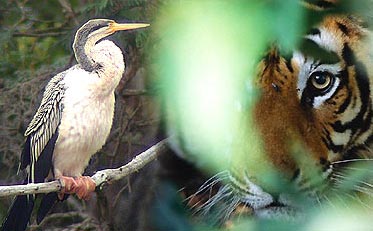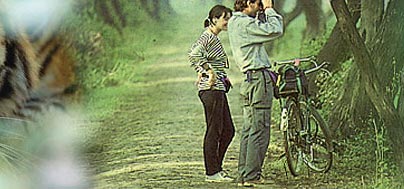 |
 |
 |
||
|
||||
Indian
Tiger
Tiger in India
Appearance and Physical Characteristics
Though slim and elegant, tigers are immensely powerful. Their front legs and paws are tremendously strong: they can kill young elephants and rhino and drag prey weighing 200 kg. (5001 bs.) Or more. Tigers walk on the fore pads of their feet, which gives their stride suppleness and elasticity. They have flexible forelegs that can twist inwards, allowing them to grasp prey. Their claws remain retracted until they are needed in the final moments of attack.
Sight and Smell
Tigers are famed for their glowing amber eyes. Unlike most other cats, they have round pupils. Tigers have acute eyesight and the cells in their eyes are sensitive to color. They can perceive depth because their eyes face forwards, thus allowing direction and distance to be judged with extreme accuracy. Tigers, like all cats, have a special adaptation that gives them excellent night vision: a membrane at the back of the eye reflects light through the light sensitive cells of the retina. This effectively doubles the intensity of dim light. The same principal is used in the "cats' eyes" on our roads.
Scent forms the basis for territorial behavior. Tigers keep track of each other's movements by scent marking, which helps them to avoid conflict. To make the best use of information contained in a scent mark, the tiger has to hang out its tongue and draw back the lips, causing the eyes to close. This is called the flehmen response and it allows the tiger to pass the scent through two small holes in the upper palate behind the incisors in effect the tiger can "test" he scent. To human eyes, the expression looks like a grimace of disgust.
Habitat
Tigers inhabit many types of forests, from the mangrove swamps of Bangladesh to the coniferous forests of the Russian Far East. Dense vegetation, plenty of pre and minimum human interference are all requirements of good tiger habitat, as are pools for drinking and bathing. Tigers of the warmer climes love water and may even sleep with part of their body submerged. They are adept swimmers. Young tigers are agile enough to climb into trees but adults are generally too heavy. However, an angry tiger in Siberia was reported to have limbed into a tree in an attempt to swat the helicopter that was following it
Predation
Tigers can kill prey that exceeds their own weight. A tiger can eat over 30 kgs (66lvbs ) of meat in a single night, though a large kill ma be needed only once or twice a week. In the meantime, snacks such a peacocks, crabs turtles, fish, lizards, small birds or even locusts will suffice. Tigers are not exclusively carnivorous and will sometimes eat jungle fruits. Their stomachs often contain earth, and his is probably ingested to aid digestion.
In India, hog deer, chital (spotted deer), barking deer, sambar, nilgai and wild boar are the favorite prey, though tigers will also kill jungle ox and even young elephants and rhino of up to 450 kgs (1000 lbs ) in weight. Tigers will seek to porcupines, even though these prickly creatures have a nasty habit of backing into a pursuer in order to drive in their spines. Injuries form porcupines may fester and can even cause the death of a tiger.
Tigers tend to hunt between dusk and dawn. They are less active during the day and may lie satiated in the shade or in a pool near the remains of a kill. Tigers often cover an unfinished meal with soil and leaves and return to it later. Even so, scavengers are quick to take advantage, though they risk annoying the owner of the kill. A tiger was photographed pouncing on a vulture in sheer exasperation and an irritable tiger will even chase away crows.
Sight and sound, rather than scent, are used to locate prey. Tigers are too large and too heavy to run for long distances and therefore must patiently stalk their prey until they are close enough to make a final lunge for the neck. Effective camouflage is essential and in patches of sunshine and shade a motionless tiger is practically invisible. Despite being one of the most feared of the world's predators, tigers are often unsuccessful in catching their prey. Prey species have acute hearing and many run faster than a tiger. Some have alarm calls that warn all the animals in the vicinity to be wary. If the tiger fails in a hunting attempt it must move to another area or wait until the forest becomes calm again.
It is interesting to compare this technique with those used in more open habitats where there is not enough cover to conceal a stalking predator. In the African Savannahs, for example, cheetahs have developed unsurpassed speed and prides of lions have learnt to hunt cooperatively. The remains of a kill are also more difficult to conceal, and any left uneaten will be quickly finished off by scavengers. Cooperative hunters therefore share the kill amongst themselves, so that nothing is wasted on those animals who are looking for a free lunch. The development of different hunting strategies to suit habitat types is part of a process known as optimization.
Tiger behavior is flexible and the choice of prey, as well as the technique for catching in, will be influenced by how plentiful the prey is and how easily it is caught. Tigers in areas where the vegetation is less dense are more likely to hunt large prey cooperatively and to share their kill. This was the case in Ranthambore National Park during the 1980s. Up to nine tigers were seen lying together in a social group, just like a pride of lions. Tiger were observed sharing their prey not only with their young, but also with other adults. Rather than a strict hierarchy, it seems that the titer that makes the kill always gets the first meal, even if the other tigers present are larger.
Tiger Cubs
Tiger cubs are born blind and helpless, weighing only 1.5 kg (3/3lbs). The cubs' eyes open after one or tow weeks. Initially blue of blue green, the eyes will darken later to glowing amber.
On average, there are three cubs in a litter, though an exceptional seven was once recorded.
Tigresses are devoted mothers and when the cubs are young, she will move them to places of safety, carrying them gently one by one in her huge, powerful jaws. Cubs are very vulnerable to attack by passing predators and many perish before their first year is out. Jackals, hyenas, leopards and pythons, as well as other tigers, are all a potential threat. The tigress must choose a carefully hidden den and leave the cubs alone for as short a time as possible while she hunts. Grass fires, which are often started deliberately to improve grazing, kill many tiger cubs.
The cub remains in the den for four to eight weeks. They then venture into the outside world for the first time and receive their first taste of meat. They keep in single file behind the tigress, and it is thought that her striped tail and the large white spots behind her ears act as beacons for the cubs to follow. The runt of the litter, if it has survived to emerge from the den, is always the last in the line of cubs and is often picked off by predators.
It is extremely rate that more than two cubs in a litter survive to maturity. Having said this, it is possible that the survival rate would be much giver given sufficient pry density. In the mid 1980's prey density in the Ranthambore National Park was so high that four cubs in the little survived to maturity in at least three cases.
The ratio of male to female cubs born is about one to one, but more females survive into adulthood because the male cubs leave the family earlier and are more likely to perish because of their inexperience at hunting. Males can also suffer injuries in territorial disputes and may be more vulnerable to huntress, as they are less wary of baits.
In contrast with the careful nurturing received by wild tigers, cubs born in captivity are usually abandoned or eaten if not immediately removed by zoo keepers . Presumably the unnatural conditions are the root cause of this aberrant behavior.
Growing Up
Tiger cubs are playful and their games together games together begin to teach them the skills necessary for survival. They stalk and pounce on leaves, insects, or even their mother's tail.
At first, the cubs must hide in the undergrowth while the tigress hunts, but later they are allowed to watch and eventually join in. the young cash help the tigress by driving the chosen victim towards her. Learning to hunt is a difficult and dangerous process and many cubs are gored of trampled to death. Inexperienced cubs tend to grab the legs of the prey, leaving them vulnerable to retaliation. Sometimes the tigress will intervene. She can bring down the prey and then leave it for the cubs to kill. It takes many attempts before he cubs learn to kill efficiently by biting the throat or the nape of the neck.
A mother tiger may allow her cubs to feed first . If she joins her young at a meal, she will withdraw if a cub protests and will go without meat to ensure that they have enough. The cubs have voracious appetites and by the time they are 14 months old , it is a strain for the tigress to capture enough prey. The runt is the last in queue at meals and if food is in scarce supply, it will starve to death.
Their lessons learned , young tigers must venture out in search of a territory. Male tigers leave their mothers at about 18-22 months old. Sub-adult males are often tolerated by other males, but this will change on reaching maturity. Each young male must then look for a vacant territory, or one where there is a chance of ousting an old or sick male. Females remain with their mothers for 24 to 28 months and will help in the capture of prey until they leave. When the tigress is ready to mate again, she might become aggressive towards her daughters. One daughter may be allowed to settle inside the mother's territory, but the rest must find space in the territories of neighboring males. Newly independent tigers lack haunting experience and a second's hesitation may leave them to go hungry.
The young tigers will become sexually mature at three to four years old and by this time are ready to found the next generation of cubs.
:: Spotting Tigers ::
Tiger in India
Appearance and Physical Characteristics
Though slim and elegant, tigers are immensely powerful. Their front legs and paws are tremendously strong: they can kill young elephants and rhino and drag prey weighing 200 kg. (5001 bs.) Or more. Tigers walk on the fore pads of their feet, which gives their stride suppleness and elasticity. They have flexible forelegs that can twist inwards, allowing them to grasp prey. Their claws remain retracted until they are needed in the final moments of attack.
Sight and Smell
Tigers are famed for their glowing amber eyes. Unlike most other cats, they have round pupils. Tigers have acute eyesight and the cells in their eyes are sensitive to color. They can perceive depth because their eyes face forwards, thus allowing direction and distance to be judged with extreme accuracy. Tigers, like all cats, have a special adaptation that gives them excellent night vision: a membrane at the back of the eye reflects light through the light sensitive cells of the retina. This effectively doubles the intensity of dim light. The same principal is used in the "cats' eyes" on our roads.
Scent forms the basis for territorial behavior. Tigers keep track of each other's movements by scent marking, which helps them to avoid conflict. To make the best use of information contained in a scent mark, the tiger has to hang out its tongue and draw back the lips, causing the eyes to close. This is called the flehmen response and it allows the tiger to pass the scent through two small holes in the upper palate behind the incisors in effect the tiger can "test" he scent. To human eyes, the expression looks like a grimace of disgust.
Habitat
Tigers inhabit many types of forests, from the mangrove swamps of Bangladesh to the coniferous forests of the Russian Far East. Dense vegetation, plenty of pre and minimum human interference are all requirements of good tiger habitat, as are pools for drinking and bathing. Tigers of the warmer climes love water and may even sleep with part of their body submerged. They are adept swimmers. Young tigers are agile enough to climb into trees but adults are generally too heavy. However, an angry tiger in Siberia was reported to have limbed into a tree in an attempt to swat the helicopter that was following it
Predation
Tigers can kill prey that exceeds their own weight. A tiger can eat over 30 kgs (66lvbs ) of meat in a single night, though a large kill ma be needed only once or twice a week. In the meantime, snacks such a peacocks, crabs turtles, fish, lizards, small birds or even locusts will suffice. Tigers are not exclusively carnivorous and will sometimes eat jungle fruits. Their stomachs often contain earth, and his is probably ingested to aid digestion.
In India, hog deer, chital (spotted deer), barking deer, sambar, nilgai and wild boar are the favorite prey, though tigers will also kill jungle ox and even young elephants and rhino of up to 450 kgs (1000 lbs ) in weight. Tigers will seek to porcupines, even though these prickly creatures have a nasty habit of backing into a pursuer in order to drive in their spines. Injuries form porcupines may fester and can even cause the death of a tiger.
Tigers tend to hunt between dusk and dawn. They are less active during the day and may lie satiated in the shade or in a pool near the remains of a kill. Tigers often cover an unfinished meal with soil and leaves and return to it later. Even so, scavengers are quick to take advantage, though they risk annoying the owner of the kill. A tiger was photographed pouncing on a vulture in sheer exasperation and an irritable tiger will even chase away crows.
Sight and sound, rather than scent, are used to locate prey. Tigers are too large and too heavy to run for long distances and therefore must patiently stalk their prey until they are close enough to make a final lunge for the neck. Effective camouflage is essential and in patches of sunshine and shade a motionless tiger is practically invisible. Despite being one of the most feared of the world's predators, tigers are often unsuccessful in catching their prey. Prey species have acute hearing and many run faster than a tiger. Some have alarm calls that warn all the animals in the vicinity to be wary. If the tiger fails in a hunting attempt it must move to another area or wait until the forest becomes calm again.
It is interesting to compare this technique with those used in more open habitats where there is not enough cover to conceal a stalking predator. In the African Savannahs, for example, cheetahs have developed unsurpassed speed and prides of lions have learnt to hunt cooperatively. The remains of a kill are also more difficult to conceal, and any left uneaten will be quickly finished off by scavengers. Cooperative hunters therefore share the kill amongst themselves, so that nothing is wasted on those animals who are looking for a free lunch. The development of different hunting strategies to suit habitat types is part of a process known as optimization.
Tiger behavior is flexible and the choice of prey, as well as the technique for catching in, will be influenced by how plentiful the prey is and how easily it is caught. Tigers in areas where the vegetation is less dense are more likely to hunt large prey cooperatively and to share their kill. This was the case in Ranthambore National Park during the 1980s. Up to nine tigers were seen lying together in a social group, just like a pride of lions. Tiger were observed sharing their prey not only with their young, but also with other adults. Rather than a strict hierarchy, it seems that the titer that makes the kill always gets the first meal, even if the other tigers present are larger.
Tiger Cubs
Tiger cubs are born blind and helpless, weighing only 1.5 kg (3/3lbs). The cubs' eyes open after one or tow weeks. Initially blue of blue green, the eyes will darken later to glowing amber.
On average, there are three cubs in a litter, though an exceptional seven was once recorded.
Tigresses are devoted mothers and when the cubs are young, she will move them to places of safety, carrying them gently one by one in her huge, powerful jaws. Cubs are very vulnerable to attack by passing predators and many perish before their first year is out. Jackals, hyenas, leopards and pythons, as well as other tigers, are all a potential threat. The tigress must choose a carefully hidden den and leave the cubs alone for as short a time as possible while she hunts. Grass fires, which are often started deliberately to improve grazing, kill many tiger cubs.
The cub remains in the den for four to eight weeks. They then venture into the outside world for the first time and receive their first taste of meat. They keep in single file behind the tigress, and it is thought that her striped tail and the large white spots behind her ears act as beacons for the cubs to follow. The runt of the litter, if it has survived to emerge from the den, is always the last in the line of cubs and is often picked off by predators.
It is extremely rate that more than two cubs in a litter survive to maturity. Having said this, it is possible that the survival rate would be much giver given sufficient pry density. In the mid 1980's prey density in the Ranthambore National Park was so high that four cubs in the little survived to maturity in at least three cases.
The ratio of male to female cubs born is about one to one, but more females survive into adulthood because the male cubs leave the family earlier and are more likely to perish because of their inexperience at hunting. Males can also suffer injuries in territorial disputes and may be more vulnerable to huntress, as they are less wary of baits.
In contrast with the careful nurturing received by wild tigers, cubs born in captivity are usually abandoned or eaten if not immediately removed by zoo keepers . Presumably the unnatural conditions are the root cause of this aberrant behavior.
Growing Up
Tiger cubs are playful and their games together games together begin to teach them the skills necessary for survival. They stalk and pounce on leaves, insects, or even their mother's tail.
At first, the cubs must hide in the undergrowth while the tigress hunts, but later they are allowed to watch and eventually join in. the young cash help the tigress by driving the chosen victim towards her. Learning to hunt is a difficult and dangerous process and many cubs are gored of trampled to death. Inexperienced cubs tend to grab the legs of the prey, leaving them vulnerable to retaliation. Sometimes the tigress will intervene. She can bring down the prey and then leave it for the cubs to kill. It takes many attempts before he cubs learn to kill efficiently by biting the throat or the nape of the neck.
A mother tiger may allow her cubs to feed first . If she joins her young at a meal, she will withdraw if a cub protests and will go without meat to ensure that they have enough. The cubs have voracious appetites and by the time they are 14 months old , it is a strain for the tigress to capture enough prey. The runt is the last in queue at meals and if food is in scarce supply, it will starve to death.
Their lessons learned , young tigers must venture out in search of a territory. Male tigers leave their mothers at about 18-22 months old. Sub-adult males are often tolerated by other males, but this will change on reaching maturity. Each young male must then look for a vacant territory, or one where there is a chance of ousting an old or sick male. Females remain with their mothers for 24 to 28 months and will help in the capture of prey until they leave. When the tigress is ready to mate again, she might become aggressive towards her daughters. One daughter may be allowed to settle inside the mother's territory, but the rest must find space in the territories of neighboring males. Newly independent tigers lack haunting experience and a second's hesitation may leave them to go hungry.
The young tigers will become sexually mature at three to four years old and by this time are ready to found the next generation of cubs.
:: Spotting Tigers ::
Indian Tiger
Tiger in India White Tiger
White Tiger  Tiger Photographic in India
Tiger Photographic in India
 Tiger Safari in FWD
Tiger Safari in FWD
 Tiger Tail
Tiger Tail  Tiger Land Tour
Tiger Land Tour
Tiger Conservation in India Tiger
Photo Gallery
Tiger
Photo Gallery  more...
more...
Tiger in India
Tiger Conservation in India
| Home | About Us | FAQ's | Contact Us | Commendations | Reservation |
| Copyright © Wildlife India Plus ( All Rights Reserved. ) | Web Development & SEO Services by |

